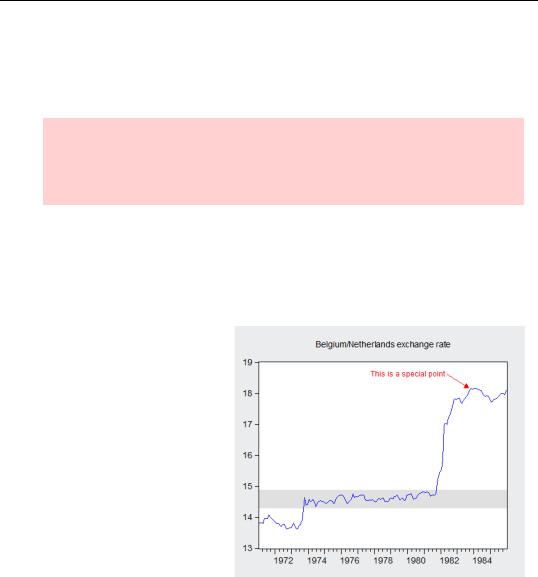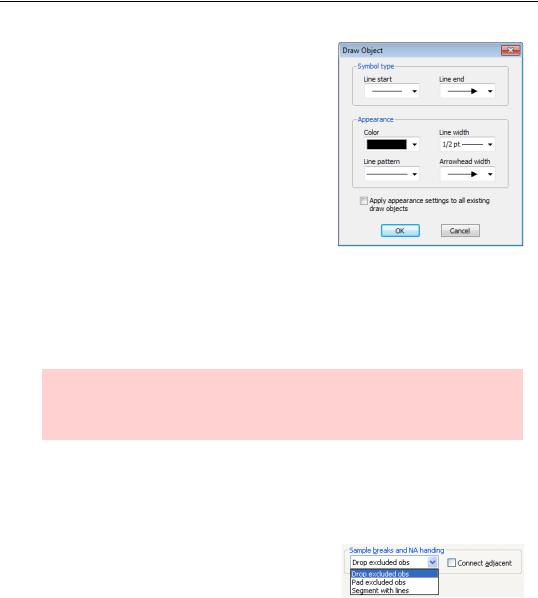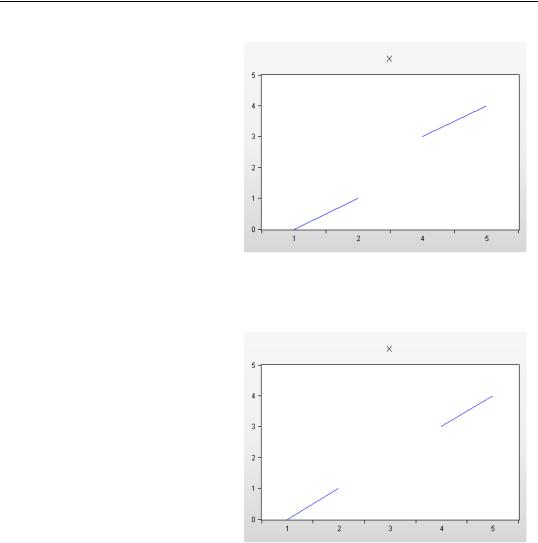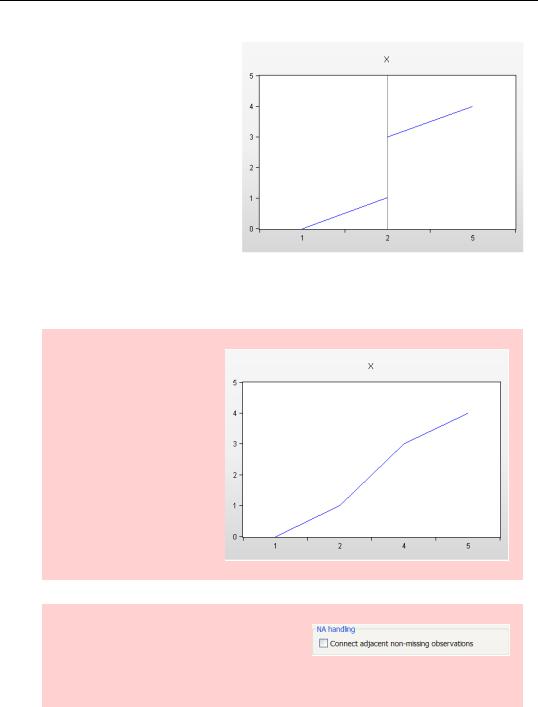
- •Table of Contents
- •Foreword
- •Chapter 1. A Quick Walk Through
- •Workfile: The Basic EViews Document
- •Viewing an individual series
- •Looking at different samples
- •Generating a new series
- •Looking at a pair of series together
- •Estimating your first regression in EViews
- •Saving your work
- •Forecasting
- •What’s Ahead
- •Chapter 2. EViews—Meet Data
- •The Structure of Data and the Structure of a Workfile
- •Creating a New Workfile
- •Deconstructing the Workfile
- •Time to Type
- •Identity Noncrisis
- •Dated Series
- •The Import Business
- •Adding Data To An Existing Workfile—Or, Being Rectangular Doesn’t Mean Being Inflexible
- •Among the Missing
- •Quick Review
- •Appendix: Having A Good Time With Your Date
- •Chapter 3. Getting the Most from Least Squares
- •A First Regression
- •The Really Important Regression Results
- •The Pretty Important (But Not So Important As the Last Section’s) Regression Results
- •A Multiple Regression Is Simple Too
- •Hypothesis Testing
- •Representing
- •What’s Left After You’ve Gotten the Most Out of Least Squares
- •Quick Review
- •Chapter 4. Data—The Transformational Experience
- •Your Basic Elementary Algebra
- •Simple Sample Says
- •Data Types Plain and Fancy
- •Numbers and Letters
- •Can We Have A Date?
- •What Are Your Values?
- •Relative Exotica
- •Quick Review
- •Chapter 5. Picture This!
- •A Simple Soup-To-Nuts Graphing Example
- •A Graphic Description of the Creative Process
- •Picture One Series
- •Group Graphics
- •Let’s Look At This From Another Angle
- •To Summarize
- •Categorical Graphs
- •Togetherness of the Second Sort
- •Quick Review and Look Ahead
- •Chapter 6. Intimacy With Graphic Objects
- •To Freeze Or Not To Freeze Redux
- •A Touch of Text
- •Shady Areas and No-Worry Lines
- •Templates for Success
- •Point Me The Way
- •Your Data Another Sorta Way
- •Give A Graph A Fair Break
- •Options, Options, Options
- •Quick Review?
- •Chapter 7. Look At Your Data
- •Sorting Things Out
- •Describing Series—Just The Facts Please
- •Describing Series—Picturing the Distribution
- •Tests On Series
- •Describing Groups—Just the Facts—Putting It Together
- •Chapter 8. Forecasting
- •Just Push the Forecast Button
- •Theory of Forecasting
- •Dynamic Versus Static Forecasting
- •Sample Forecast Samples
- •Facing the Unknown
- •Forecast Evaluation
- •Forecasting Beneath the Surface
- •Quick Review—Forecasting
- •Chapter 9. Page After Page After Page
- •Pages Are Easy To Reach
- •Creating New Pages
- •Renaming, Deleting, and Saving Pages
- •Multi-Page Workfiles—The Most Basic Motivation
- •Multiple Frequencies—Multiple Pages
- •Links—The Live Connection
- •Unlinking
- •Have A Match?
- •Matching When The Identifiers Are Really Different
- •Contracted Data
- •Expanded Data
- •Having Contractions
- •Two Hints and A GotchYa
- •Quick Review
- •Chapter 10. Prelude to Panel and Pool
- •Pooled or Paneled Population
- •Nuances
- •So What Are the Benefits of Using Pools and Panels?
- •Quick (P)review
- •Chapter 11. Panel—What’s My Line?
- •What’s So Nifty About Panel Data?
- •Setting Up Panel Data
- •Panel Estimation
- •Pretty Panel Pictures
- •More Panel Estimation Techniques
- •One Dimensional Two-Dimensional Panels
- •Fixed Effects With and Without the Social Contrivance of Panel Structure
- •Quick Review—Panel
- •Chapter 12. Everyone Into the Pool
- •Getting Your Feet Wet
- •Playing in the Pool—Data
- •Getting Out of the Pool
- •More Pool Estimation
- •Getting Data In and Out of the Pool
- •Quick Review—Pools
- •Chapter 13. Serial Correlation—Friend or Foe?
- •Visual Checks
- •Testing for Serial Correlation
- •More General Patterns of Serial Correlation
- •Correcting for Serial Correlation
- •Forecasting
- •ARMA and ARIMA Models
- •Quick Review
- •Chapter 14. A Taste of Advanced Estimation
- •Weighted Least Squares
- •Heteroskedasticity
- •Nonlinear Least Squares
- •Generalized Method of Moments
- •Limited Dependent Variables
- •ARCH, etc.
- •Maximum Likelihood—Rolling Your Own
- •System Estimation
- •Vector Autoregressions—VAR
- •Quick Review?
- •Chapter 15. Super Models
- •Your First Homework—Bam, Taken Up A Notch!
- •Looking At Model Solutions
- •More Model Information
- •Your Second Homework
- •Simulating VARs
- •Rich Super Models
- •Quick Review
- •Chapter 16. Get With the Program
- •I Want To Do It Over and Over Again
- •You Want To Have An Argument
- •Program Variables
- •Loopy
- •Other Program Controls
- •A Rolling Example
- •Quick Review
- •Appendix: Sample Programs
- •Chapter 17. Odds and Ends
- •How Much Data Can EViews Handle?
- •How Long Does It Take To Compute An Estimate?
- •Freeze!
- •A Comment On Tables
- •Saving Tables and Almost Tables
- •Saving Graphs and Almost Graphs
- •Unsubtle Redirection
- •Objects and Commands
- •Workfile Backups
- •Updates—A Small Thing
- •Updates—A Big Thing
- •Ready To Take A Break?
- •Help!
- •Odd Ending
- •Chapter 18. Optional Ending
- •Required Options
- •Option-al Recommendations
- •More Detailed Options
- •Window Behavior
- •Font Options
- •Frequency Conversion
- •Alpha Truncation
- •Spreadsheet Defaults
- •Workfile Storage Defaults
- •Estimation Defaults
- •File Locations
- •Graphics Defaults
- •Quick Review
- •Index
- •Symbols

Point Me The Way—177
use the dialog to add the graph to the Predefined templates list. Note that predefined templates don't include text or lines/shades from the original graph.
You can make any template the default for all new graphs by going to the Options/Graphics Defaults… menu and then choosing the desired template from the Apply template page.
Work around hint: Since predefined templates don’t include line/shades, you can’t just add the Recessions graph to the Predefined template list and have recession shading globally available. Hence, the hint on page 174 about copy-and-pasting a graph that you wish to use as a template.
Point Me The Way
If you’d like to point out a certain observation in your data, you might want to select Draw Arrow from the right-click menu or the Proc button. The mouse cursor will turn into a crosshair. Click at the starting point, and while continuing to hold down the mouse button, drag and release at the arrow endpoint.
You don’t have to be too careful about how you initially draw your arrow, because EViews allows you to change its size and position afterward. Whenever you move your mouse over the arrow, EViews will change the cursor to indicate what action will be taken if you drag. When the cursor is a crosshair, you can drag and relocate the arrow. If your mouse is over the ends of the arrow, the cursor indicates it will resize the arrow if you drag. You can then freely drag the endpoint in any direction, resizing
and reshaping the arrow as you please.

178—Chapter 6. Intimacy With Graphic Objects
Double click on the arrow to bring up the customization dialog. You can select different endpoints for the arrow: none, filled arrow, hollow arrow, or perpendicular line. You can also set the arrow color, width, and line properties.
To apply the settings to all arrows in the graph, check the box at the bottom of the dialog.
If you’d like to delete an arrow, select it and press the Delete key, just as with other EViews objects.
Your Data Another Sorta Way
You can sort a spreadsheet view. (See Sorting Things Out in Chapter 7, “Look At Your Data.”) You can also sort the data in a frozen graph. Choose Sort… from the  button or the right-click menu.
button or the right-click menu.
Hint: As mentioned earlier, you must freeze a graph before you sort it. Sort… rearranges the data, so if you try to sort a histogram or other plot where sorting isn’t sen- sible—EViews sensibly doesn’t do anything.
In addition to being able to sort according to the values in as many as three of your data series, you can sort according the value of observation labels.
Give A Graph A Fair Break
If there’s a break in your sample, how would you like that break to be displayed in a graph? EViews offers three options in the Graph Options dialog. In order to have something simple for an illustration, we’ve created a series 1, 2, 3, 4, 5 and then set the sample
with smpl 1 2 4 5, so the middle observation is missing.

Give A Graph A Fair Break—179
•Drop excluded obs deletes the missing part of the sample from the x-axis. Notice that it looks like the distance between 2 and 4 is the same as the distance between 1 and 2 or 4 and 5. This makes sense if the x- coordinates are ordinal, but isn’t so good if they’re cardinal. In other words, dropping part of the x-axis works if the measurements are things like “strongly agree,” “agree”, “indiffer-
ent,” but doesn’t work so well for measurements like “1 mile from the Eiffel Tower,” “2 miles from the Eiffel Tower,” etc.
•Pad excluded obs leaves in the part of the x-axis for which data are missing. It’s better for cardinal ordinates.

180—Chapter 6. Intimacy With Graphic Objects
•Segment with lines is a stronger version of Drop excluded, deleting more of the missing x-axis, with an added vertical lines to show the break points. Segment with lines is the most “intellectually honest” display, because it makes sure everyone knows where breaks in the sample occur. The two disadvantages are that it’s not always the most aesthetically pleasing picture (especially if there are
lots of breaks) and that the vertical line draws attention to the sample break, which may or may not be a particularly interesting part of the data.
Hint: Checking Connect adjacent for either of the first two choices connects points on either side of the sample break. This frequently makes for a nicer looking picture, but can be misleading if it appears to report data that isn’t there.
Hint: You control whether lines are connected over NAs with the NA Handling option. You can also use the broken sample options by including not @isna(x) in the if part of your smpl statement.
